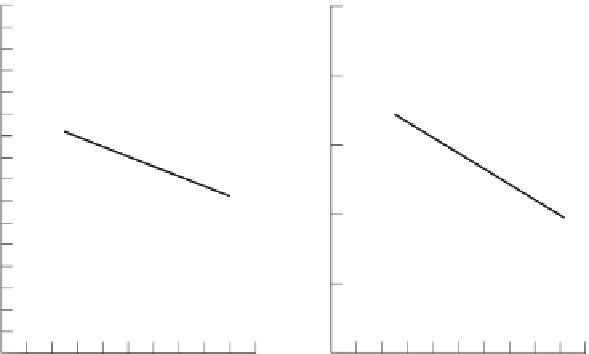Environmental Engineering Reference
In-Depth Information
Fig. 9.19
Relationships
between percentage
development (for
pasture and urban use)
of the catchment area of
tributaries of the
Kakaunui River and (a)
the Macroinvertebrate
Community Index
(MCI), commonly used
by river managers in
New Zealand, and (b) a
Maori Cultural Stream
Health Measure
(CSHM). (After
Tow n send et al., 2004.)
(a)
(b)
160
5
4
120
3
80
2
40
1
0
0
60
80
100
60
80
100
% Catchment developed
% Catchment developed
river healthy if it contains big fi sh of desired species; parents if their children do
not get sick when swimming; conservationists if native species are well represented.
The Kakaunui River in New Zealand is within the territory of a Maori group who
developed an index that represented their perceptions of river health. Their Cultural
Stream Health Measure (CSHM) includes components that refl ect the perceived
extent to which the surrounding catchment area, the riparian zone, the banks and
the streambed have been impacted by humans. The CSHM (Figure 9.19b) is strongly
correlated with the MCI despite the fact that it included no invertebrate component.
Both indexes have merit in refl ecting the effect of human
pressures
on the
state
of
the ecosystem.
You have seen how particular taxonomic groups may lend themselves to use as
ecosystem health indicators, including predatory soil mites, bats and stream inver-
tebrates. A somewhat surprising alternative might be to use parasites as indicators.
Marcogliese (2005) points out, for example, that the species richness of metazoan
parasites of American eels (
Anguilla rostrate
) declines with level of acidifi cation in
North American streams (associated with acid rain caused by power generation).
Moreover, the percentage infestation of another fi sh (spottail shiner -
Notropis hud-
sonius
) by myxozoan parasites increases below an urban effl uent outfl ow. Parasites
might prove good ecosystem health indicators, either because they are especially
sensitive themselves to heavy metals or exotic chemicals, or because they have
intermediate hosts that decline (or increase) as a result of the pressure concerned.
9.8.5
Ecosystem
health of a marine
environment
My fi nal example comes from Tolo Harbor in northeast Hong Kong, an almost land-
locked marine water body with an area of 52 km
2
. The most signifi cant physical and
chemical
pressures
since the 1970s have been caused by increased urbanization
(urban r unoff and sewage), reservoir development (affecting patterns of freshwater
input), industrialization (pollutants) and livestock rearing. Industrial pollutants and


































Search WWH ::

Custom Search